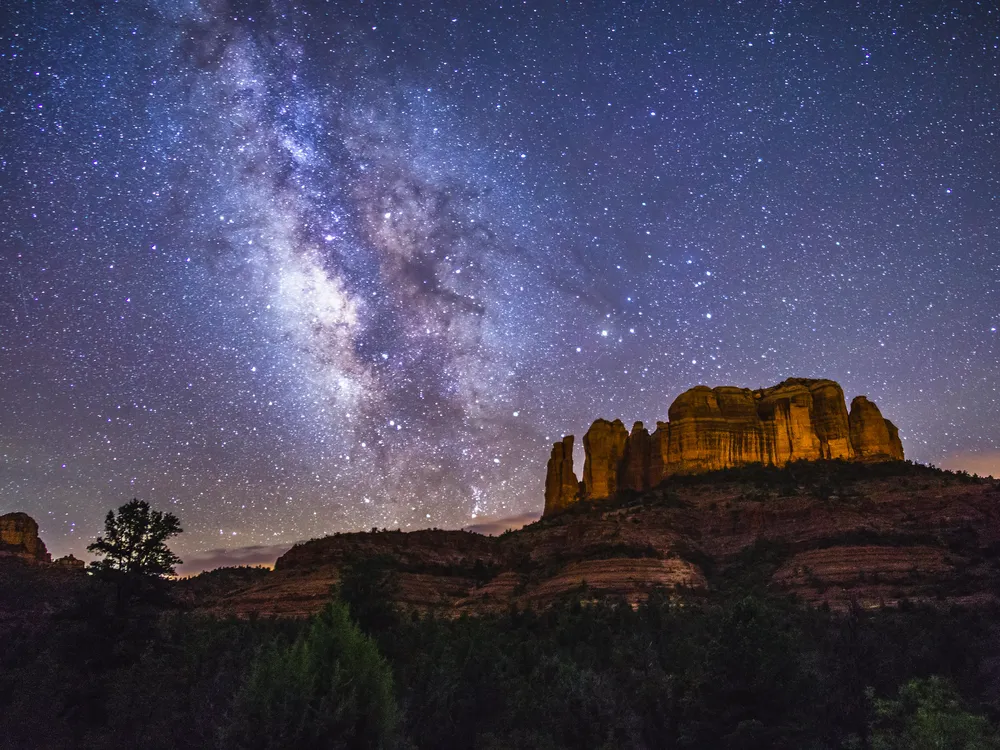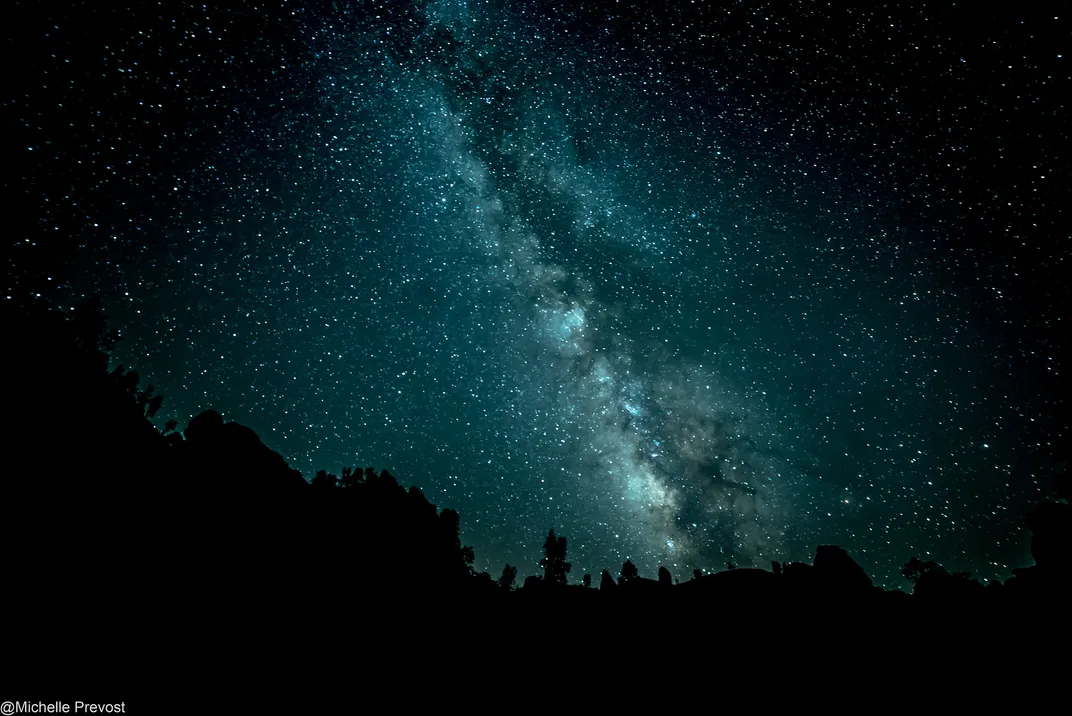How to See the Milky Way This Weekend
Late August is a great time to observe the dazzling core of our galaxy, and with the upcoming new moon, viewing conditions should be ideal—as long as you’re in a very dark area

The starry night sky can look like a salt shaker has tipped over and spread its contents across the cosmos. And, if the timing is right, you might even see a hazy belt stretched across the sky—the starry, dusty core of our very own Milky Way galaxy.
Right now is a peak time for United States-based viewers to glimpse the magnificent galactic core.
“In late August, the Milky Way reaches its highest point in the sky, where the core is directly overhead,” Michael West, an astronomer at the Lowell Observatory in Flagstaff, Arizona, tells Smithsonian magazine in an email. “This is the best time of year to see it clearly, because it’s high above the horizon.”
However, there’s a catch—to see the Milky Way, you’ll need very dark skies. And about 80 percent of North Americans live in areas that are too bright due to artificial light pollution for the Milky Way to ever be visible.
So, to witness the heart of our galaxy, you might have to travel a bit. But if you do, you’ll be rewarded with a spectacle that’s likely only growing rarer as city lights proliferate.
With a new moon coming on Monday, conditions should already be ideal for viewing in a dark area. Here’s a guide to making the most of a summer Milky Way-spotting session.
What is the core of the Milky Way?
/https://tf-cmsv2-smithsonianmag-media.s3.amazonaws.com/filer_public/33/ff/33ffc300-2b01-4f1d-9bb4-c49f47ce5f75/milky_way.webp)
The Milky Way galaxy contains around 100 billion stars, all orbiting the galactic center, where a supermassive black hole lies. Our solar system is located 26,000 light-years from the middle of our galaxy—“in the suburbs,” as NASA says—and it takes about 250 million years for it to make one orbit.
Because of our positioning within the galactic disk, we can’t see the spiral shape of our galaxy—or the bar that cuts through it. But looking toward the south, we can peer into its core.
“The Milky Way’s core is the heart of our home galaxy,” West says. “It’s packed with stars, gas and dust, making it the most vibrant part of the Milky Way.”
If we lived in the core of the Milky Way, we would see up to one million times more stars in the night sky. There, the crowding of stars is so dense that the typical spiral structure of the galaxy breaks down, and it forms just a “bulge” of stars and dust. And at the center is Sagittarius A*, our nearest black hole, which has four million times the mass of the sun. Astronomers imaged the black hole for the first time in 2022.
When can you see the Milky Way?
The core of the Milky Way is visible from approximately mid-February to October, but from the Northern Hemisphere, “the most stunning views are during the summer, from June to August,” West says. For most of the planet, the core of our galaxy first becomes visible in the early morning hours of February, then it slowly creeps earlier each night until it can be seen only in the late evening in October skies.
Over this week and next week, start looking for the Milky Way around 9 or 10 p.m., West adds. The fuzzy band should remain visible until between 2 and 4 a.m.
The best nights to look take place around a new moon, when you’ll have minimal interference from Earth’s natural satellite. With the next new moons on September 2 and October 2, the best upcoming viewing windows are now through September 6 and September 24 to October 5, writes Forbes’ Jamie Carter.
Tips for spotting the Milky Way

First and foremost, find a dark spot. This is the most crucial aspect of sighting the Milky Way. Even a bright moon can wash out the dimmer stars of the hazy galactic core.
If you live in an urban area, drive away from city lights. Find a national park, an International Dark Sky Place or other recognized Dark Site; or, check a light pollution map to pinpoint the darkest skies near you.
Once you’ve found your ideal site, allow your eyes time to acclimate to the darkness. That means no looking at your phone, as it will damage your night vision. A solid 20 to 30 minutes will be enough time to adjust, bringing out the colors and fainter objects in the sky.
Finally, look toward the south. The core of the Milky Way lies in the direction of the constellation Sagittarius, the centaur. Some of this constellation’s stars form the shape of a teapot, and though the dusty core of the galaxy will cover a lot of area, the spout of the teapot points right to the galactic center.
As with any sky-watching activity, make sure to check the weather forecast—clouds can quickly end an evening of star gazing.
The growing risk of light pollution
For much of human history, people across the Earth could look up and see the Milky Way, provided it was the right time of year, on any clear night. But now, that experience is much rarer. Scientists in 2016 calculated that one-third of the world’s population—including nearly 80 percent of North Americans and 60 percent of Europeans—cannot see the core of our galaxy from where they live. More than 80 percent of humans live in light-polluted areas, per the study, which was published in Science Advances.
The disappearance of the Milky Way from Earth’s skies is a “cultural loss of unprecedented magnitude,” the study’s lead author, Fabio Falchi of the Light Pollution Science and Technology Institute in Italy, told the Guardian’s Nicola Davis in 2016.
Light pollution can be mitigated, however, through initiatives such as the Lights Out programs meant to shut off artificial light sources to support migratory birds, or by simply shielding or aiming outdoor lights downward to prevent their glow from shining on the sky.
With a well-planned trip to a dark sky site, city and suburb residents can still experience the Milky Way’s splendor.
Astronomer John Barentine used to manage the International Dark Sky Places program, and through his work, he talked with many urban-dwellers after they saw the Milky Way for the first time.
“It was rare that I’d talk to somebody who kind of shrugged their shoulders,” he told Smithsonian magazine’s Brian Handwerk last year. “Many described it as a deeply spiritual, even [a] religious experience that I think taps into something that’s deep in our core as human beings.”